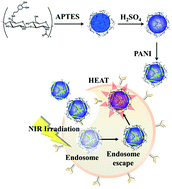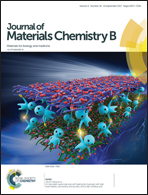Target-specific induced hyaluronic acid decorated silica fluorescent nanoparticles@polyaniline for bio-imaging guided near-infrared photothermal therapy†
Abstract
We describe a novel synthesis method for silica nanoparticles, which involves a combination of these nanoparticles with targetable and nontargetable fluorescent dopamine-conjugated hyaluronic acid (HA–DA) via rational chemical dehydration. The resulting HA-decorated silica fluorescent nanoparticles, electrostatically linked to polyaniline (PANI) to form ionic complexes, possessed high fluorescence intensity and were monodisperse in solution, near-infrared light responsive, and amenable to specific labeling of cancer cell lines. When exposed to near-infrared irradiation, the fluorescent silica nanoparticles exerted photothermal cytotoxicity guided by bioimaging and distinguished malignant cancer cells from normal cells via receptor CD44. Different heating properties of nanoparticles depend on local interactions between different structures, and determination of their efficacy could lead to new thermal treatment options such as noninvasive photothermal therapy.



 Please wait while we load your content...
Please wait while we load your content...